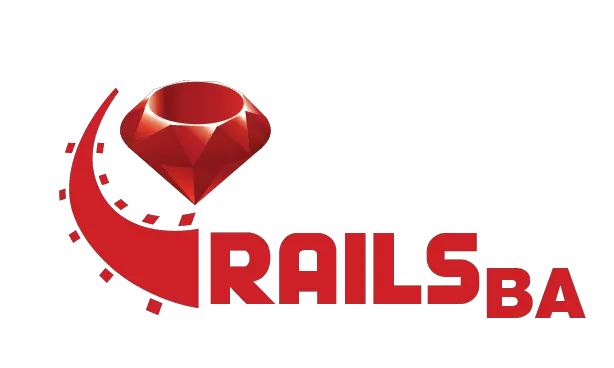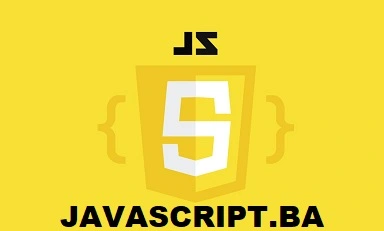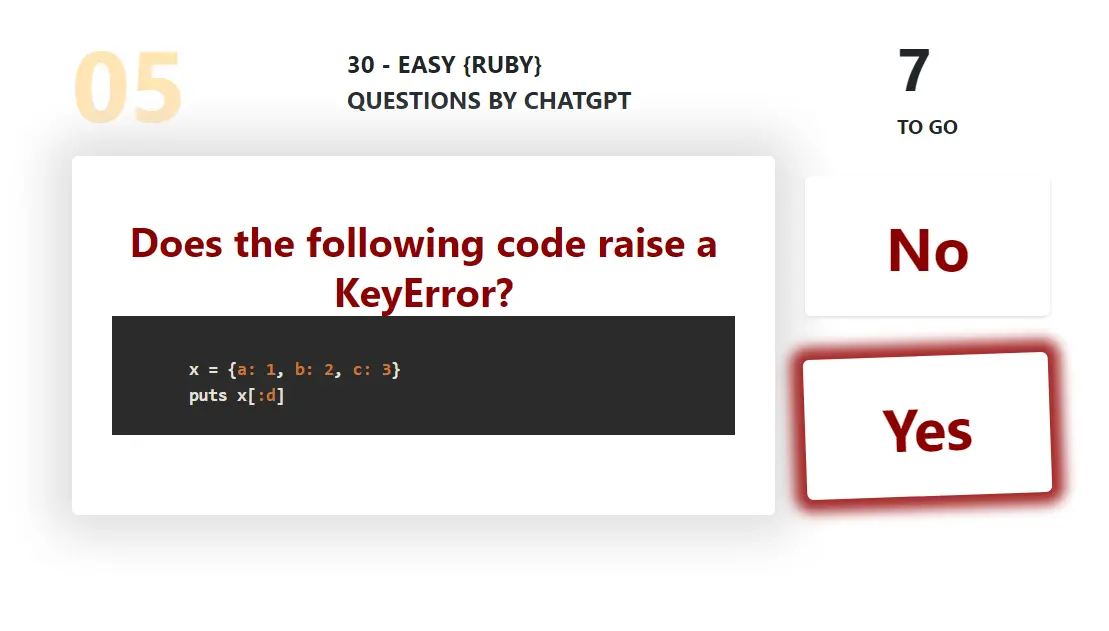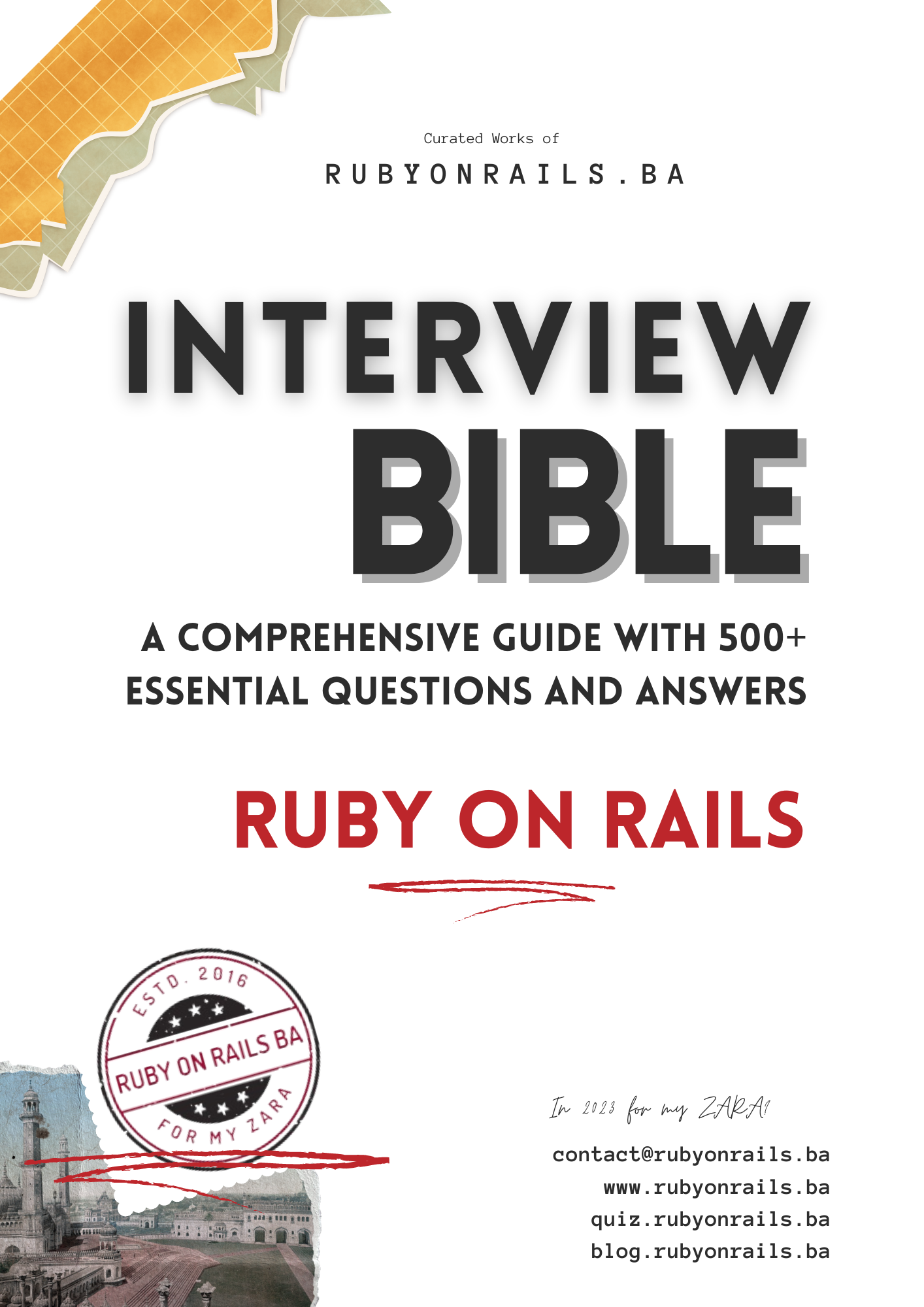
100 Ruby on Rails Interview Questions: Answers and Tips for Developers 30/03/2023 ~ Views: 2288
-
What is Ruby on Rails?
Answer: Ruby on Rails is a web application framework written in the Ruby programming language that follows the Model-View-Controller (MVC) architectural pattern. -
What is the difference between a gem and a plugin?
Answer: A gem is a library or package in Ruby that can be installed and used in a project, while a plugin is a piece of code that extends the functionality of an application. -
What are the components of Rails?
Answer: The components of Rails are the Model, View, Controller, and Routing. -
Explain the concept of Convention over Configuration in Rails.
Answer: Convention over Configuration is a principle in Rails that suggests that the developer should follow certain conventions while developing the application, and Rails will automatically configure the rest of the application accordingly. -
What is a migration in Rails?
Answer: A migration is a way to modify the database schema using Ruby code. It allows you to change the database schema without having to manually update the SQL code. -
What are the various types of associations in Rails?
Answer: The various types of associations in Rails are has_one, has_many, belongs_to, and has_and_belongs_to_many. -
What is the purpose of before_filter in Rails?
Answer: before_filter is a callback method that is used to execute some code before a controller action is called. -
What is the difference between include and extend in Ruby?
Answer: include is used to add the functionality of a module to an instance of a class, while extend is used to add the functionality of a module to the class itself. -
What is the purpose of attr_accessor in Ruby?
Answer: attr_accessor is a Ruby method that creates getter and setter methods for a class attribute. -
What is the difference between HTTP GET and POST requests?
Answer: HTTP GET requests are used to retrieve data from a server, while HTTP POST requests are used to send data to a server. -
What is the purpose of the asset pipeline in Rails?
Answer: The asset pipeline is a way to manage and organize assets such as JavaScript, CSS, and images in a Rails application. -
What is RESTful routing in Rails?
Answer: RESTful routing is a way to define routes in a Rails application that conform to the REST architectural style. -
What is the purpose of the yield keyword in Rails layouts?
Answer: The yield keyword in a Rails layout is used to specify where the content of a view should be placed in the layout. -
What is a rake task in Rails?
Answer: A rake task is a script that is used to automate repetitive tasks in a Rails application. -
What is a serializer in Rails?
Answer: A serializer is a way to convert objects in a Rails application into a format that can be easily consumed by other applications or services. -
What is the purpose of the Rails console?
Answer: The Rails console is a command-line tool that allows you to interact with a Rails application and test code snippets. -
What is the difference between a scope and a class method in Rails?
Answer: A scope is a predefined query that can be chained with other queries, while a class method is a method that can be called on a model without a specific scope. -
What is the purpose of the belongs_to association in Rails?
Answer: The belongs_to association in Rails is used to define a one-to-one or many-to-one relationship between two database tables. It is typically used to establish a relationship between a child table and a parent table, where the child table has a foreign key that references the parent table's primary key. -
What is the purpose of the has_many association in Rails?
Answer: The has_many association in Rails is used to define a one-to-many relationship between two database tables. It is typically used to establish a relationship between a parent table and a child table, where the parent table's primary key is referenced as a foreign key in the child table. -
What is the purpose of the has_and_belongs_to_many association in Rails?
Answer: The has_and_belongs_to_many association in Rails is used to define a many-to-many relationship between two database tables. It is typically used to establish a relationship between two tables where each record in one table can be associated with multiple records in the other table, and vice versa. -
What is the purpose of the validates method in Rails?
Answer: The validates method in Rails is used to define validation rules for a model's attributes. It allows developers to specify what data is valid for a particular attribute and what data is not. Common validation rules include presence, length, numericality, and format. -
What is the purpose of the has_secure_password method in Rails?
Answer: The has_secure_password method in Rails is used to add authentication functionality to a model. It automatically adds password hashing and salting, as well as methods for password validation and authentication. It requires that the model has a password_digest attribute in the database. -
What is the purpose of the params hash in Rails?
Answer: The params hash in Rails is a way to access data submitted in a request, typically from a form or URL parameters. It allows developers to easily access and manipulate this data within their controller actions and other parts of the application. -
What is the purpose of the Gemfile in a Rails application?
Answer: The Gemfile is a file that is used to specify the gems that a Rails application depends on. -
What is the difference between a local variable and an instance variable in Ruby?
Answer: A local variable is a variable that is scoped to a particular method or block, while an instance variable is a variable that is scoped to a particular instance of a class. -
What is the purpose of the strong parameters feature in Rails?
Answer: The strong parameters feature in Rails is a way to ensure that only certain parameters can be passed into a controller action, which helps to prevent security vulnerabilities such as SQL injection attacks. -
What is the purpose of the flash hash in Rails?
Answer: The flash hash in Rails is a way to store temporary data that is only available for one request and is typically used to display flash messages to the user. -
What is the difference between a hash and an array in Ruby?
Answer: An array is an ordered collection of elements, while a hash is an unordered collection of key-value pairs. -
What is the purpose of the application layout file in a Rails application?
Answer: The application layout file in a Rails application is a template that is used to define the overall layout of the application. -
What is the purpose of the ActiveRecord class in Rails?
Answer: The ActiveRecord class in Rails is a way to interact with a database using object-oriented programming concepts. -
What is the purpose of the form_for helper in Rails?
Answer: The form_for helper in Rails is a way to generate HTML forms that are tied to a particular model and can be used to create, update, or delete records. -
What is the purpose of the sanitize method in Rails?
Answer: The sanitize method in Rails is a way to remove any potentially harmful HTML tags or attributes from a string. -
What is the difference between a has_many :through and a has_and_belongs_to_many association in Rails?
Answer: A has_many :through association requires the use of an intermediate model, while a has_and_belongs_to_many association does not. -
What is the purpose of the gemspec file in a Ruby gem?
Answer: The gemspec file in a Ruby gem is a file that is used to specify information about the gem, such as its name, version, dependencies, and files. -
What is the purpose of the require keyword in Ruby?
Answer: The require keyword in Ruby is used to load a file or library into the current Ruby program. -
What is the difference between a private and a protected method in Ruby?
Answer: A private method can only be called from within the same object, while a protected method can be called from within the same object or any descendant objects. -
What is the purpose of the root route in a Rails application?
Answer: The root route in a Rails application is the default route that is used when a user visits the root URL of the application. -
What is the difference between a string and a symbol in Ruby?
Answer: A string is a collection of characters, while a symbol is a unique identifier that is used to represent a value. -
What is the purpose of the gemfile.lock file in a Rails application?
Answer: The gemfile.lock file in a Rails application is a file that is generated automatically and is used to specify the exact versions of the gems that a Rails application is using. -
What is the purpose of the yield_self method in Ruby?
Answer: The yield_self method in Ruby is a way to pass the result of a block as an argument to a method call. -
What is the purpose of the flash.now hash in Rails?
Answer: The flash.now hash in Rails is a way to store temporary data that is only available for the current request and is typically used to display flash messages to the user. -
What is the purpose of the respond_to method in Rails?
Answer: The respond_to method in Rails is a way to specify the format of the response that should be returned by a controller action. -
What is the purpose of the validates method in Rails?
Answer: The validates method in Rails is a way to define validations for model attributes, which are used to ensure that the data stored in the database is valid. -
What is the purpose of the before_action callback in Rails?
Answer: The before_action callback in Rails is a way to specify a method that should be called before a controller action is executed, which can be used to perform common tasks such as setting up authentication or authorization. -
What is the difference between a class method and an instance method in Ruby?
Answer: A class method is a method that can be called on a class itself, while an instance method is a method that can only be called on an instance of a class. -
What is the purpose of the has_secure_password method in Rails?
Answer: The has_secure_password method in Rails is a way to add password encryption and authentication functionality to a Rails model. -
What is the difference between a block and a lambda in Ruby?
Answer: A block is a piece of code that can be passed to a method, while a lambda is a type of anonymous function that can be assigned to a variable and called like a method. -
What is the purpose of the collection_select helper in Rails?
Answer: The collection_select helper in Rails is a way to generate a dropdown list that is populated with data from a database table. -
What is the purpose of the find_by method in Rails?
Answer: The find_by method in Rails is a way to find a record in a database based on a specific attribute value. -
What is the purpose of the attr_accessor method in Ruby?
Answer: The attr_accessor method in Ruby is a way to define getter and setter methods for a class attribute. -
What is the purpose of the belongs_to association in Rails?
Answer: The belongs_to association in Rails is a way to define a one-to-one or many-to-one relationship between two models. -
What is the purpose of the has_one association in Rails?
Answer: The has_one association in Rails is a way to define a one-to-one relationship between two models. -
What is the purpose of the belongs_to_many association in Rails?
Answer: The belongs_to_many association in Rails is a way to define a many-to-many relationship between two models. -
What is the purpose of the validates_presence_of method in Rails?
Answer: The validates_presence_of method in Rails is a way to ensure that a model attribute is not blank or nil. -
What is the purpose of the validates_uniqueness_of method in Rails?
Answer: The validates_uniqueness_of method in Rails is a way to ensure that a model attribute is unique among all the records in the database. -
What is the purpose of the has_one_through association in Rails?
Answer: The has_one_through association in Rails is a way to define a one-to-one relationship between two models that are not directly related. -
What is the purpose of the before_save callback in Rails?
Answer: The before_save callback in Rails is a way to specify a method that should be called before a record is saved to the database, which can be used to perform common tasks such as updating timestamps or calculating derived values. -
What is the purpose of the after_save callback in Rails?
Answer: The after_save callback in Rails is a way to specify a method that should be called after a record is saved to the database, which can be used to perform common tasks such as updating associated records or sending notifications. -
What is the purpose of the before_create callback in Rails?
Answer: The before_create callback in Rails is a way to specify a method that should be called before a new record is created in the database, which can be used to perform common tasks such as setting default values or generating unique identifiers. -
What is the purpose of the after_create callback in Rails?
Answer: The after_create callback in Rails is a way to specify a method that should be called after a new record is created in the database, which can be used to perform common tasks such as sending notifications or updating associated records. -
What is the purpose of the before_destroy callback in Rails?
Answer: The before_destroy callback in Rails is a way to specify a method that should be called before a record is destroyed in the database, which can be used to perform common tasks such as checking for dependent records or updating associated records. -
What is the purpose of the after_destroy callback in Rails?
Answer: The after_destroy callback in Rails is a way to specify a method that should be called after a record is destroyed in the database, which can be used to perform common tasks such as cleaning up associated records or sending notifications. -
What is the purpose of the belongs_to_polymorphic association in Rails?
Answer: The belongs_to_polymorphic association in Rails is a way to define a polymorphic relationship between two models, where the associated model can be of any type. -
What is the purpose of the has_many_polymorphic association in Rails?
Answer: The has_many_polymorphic association in Rails is a way to define a polymorphic relationship between two models, where the associated model can be of any type and can be associated with multiple records. -
What is the purpose of the delegate method in Rails?
Answer: The delegate method in Rails is a way to define a method in a model that delegates its implementation to another object, such as an associated record. -
What is the purpose of the scope method in Rails?
Answer: The scope method in Rails is a way to define a named scope for a model, which can be used to filter records based on a specific set of conditions. -
What is the purpose of the pluck method in Rails?
Answer: The pluck method in Rails is a way to retrieve a specific column or set of columns from a database table as an array. -
What is the purpose of the enum method in Rails?
Answer: The enum method in Rails is a way to define a set of named values for a model attribute, which can be used to simplify validation and querying. -
What is the purpose of the has_many_through association in Rails?
Answer: The has_many_through association in Rails is a way to define a many-to-many relationship between two models through an intermediate model. -
What is the purpose of the through option in Rails associations?
Answer: The through option in Rails associations is a way to specify the intermediate model for a many-to-many relationship, when using the has_many_through or has_one_through associations. -
What is the purpose of the dependent option in Rails associations?
Answer: The dependent option in Rails associations is a way to specify what should happen to associated records when a record is destroyed, such as destroying them, nullifying their foreign keys, or restricting their deletion. -
What is the purpose of the validates_format_of method in Rails?
Answer: The validates_format_of method in Rails is a way to ensure that a model attribute matches a specific regular expression. -
What is the purpose of the validates_length_of method in Rails?
Answer: The validates_length_of method in Rails is a way to ensure that a model attribute has a specific length or falls within a specific range of lengths. -
What is the purpose of the validates_numericality_of method in Rails?
Answer: The validates_numericality_of method in Rails is a way to ensure that a model attribute is a valid numeric value. -
What is the purpose of the validates_associated method in Rails?
Answer: The validates_associated method in Rails is a way to ensure that all associated records for a given model are valid. -
What is the purpose of the validates_presence_of method in Rails?
Answer: The validates_presence_of method in Rails is a way to ensure that a model attribute is present and not blank. -
What is the purpose of the validates_uniqueness_of method in Rails?
Answer: The validates_uniqueness_of method in Rails is a way to ensure that a model attribute is unique across all records in a database table. -
What is the purpose of the validates_inclusion_of method in Rails?
Answer: The validates_inclusion_of method in Rails is a way to ensure that a model attribute is included in a specific set of values. -
What is the purpose of the validates_exclusion_of method in Rails?
Answer: The validates_exclusion_of method in Rails is a way to ensure that a model attribute is excluded from a specific set of values. -
What is the purpose of the validates_acceptance_of method in Rails?
Answer: The validates_acceptance_of method in Rails is a way to ensure that a boolean model attribute is set to true. -
What is the purpose of the validates_confirmation_of method in Rails?
Answer: The validates_confirmation_of method in Rails is a way to ensure that a model attribute is confirmed by the user, typically through a second input field. -
What is the purpose of the after_save callback in Rails?
Answer: The after_save callback in Rails is a way to specify a method that should be called after a record is saved to the database, which can be used to perform common tasks such as sending notifications or updating associated records. -
What is the purpose of the before_update callback in Rails?
Answer: The before_update callback in Rails is a way to specify a method that should be called before a record is updated in the database, which can be used to perform common tasks such as generating a slug or updating a timestamp. -
What is the purpose of the after_update callback in Rails?
Answer: The after_update callback in Rails is a way to specify a method that should be called after a record is updated in the database, which can be used to perform common tasks such as sending notifications or updating associated records. -
What is the purpose of the before_commit callback in Rails?
Answer: The before_commit callback in Rails is a way to specify a method that should be called before a transaction is committed to the database, which can be used to perform common tasks such as updating associated records. -
What is the purpose of the before_rollback callback in Rails?
Answer: The before_rollback callback in Rails is a way to specify a method that should be called before a transaction is rolled back, which can be used to perform common tasks such as cleaning up temporary files or sending notifications. -
What is the purpose of the around_save callback in Rails?
Answer: The around_save callback in Rails is a way to specify a method that should be called before and after a record is saved to the database, which can be used to perform common tasks such as logging or updating dependent records. -
What is the purpose of the around_create callback in Rails?
Answer: The around_create callback in Rails is a way to specify a method that should be called before and after a record is created in the database, which can be used to perform common tasks such as generating a slug or updating a timestamp. -
What is the purpose of the around_update callback in Rails?
Answer: The around_update callback in Rails is a way to specify a method that should be called before and after a record is updated in the database, which can be used to perform common tasks such as logging or sending notifications. -
What is the purpose of the around_destroy callback in Rails?
Answer: The around_destroy callback in Rails is a way to specify a method that should be called before and after a record is destroyed from the database, which can be used to perform common tasks such as logging or updating associated records. -
What is the purpose of the before_filter method in Rails?
Answer: The before_filter method in Rails is a way to specify a method that should be called before a controller action is executed, which can be used to perform common tasks such as authentication or authorization. -
What is the purpose of the skip_before_filter method in Rails?
Answer: The skip_before_filter method in Rails is a way to skip the execution of a specified before_filter method for a controller action. -
What is the purpose of the after_filter method in Rails?
Answer: The after_filter method in Rails is a way to specify a method that should be called after a controller action is executed, which can be used to perform common tasks such as logging or sending notifications. -
What is the purpose of the skip_after_filter method in Rails?
Answer: The skip_after_filter method in Rails is a way to skip the execution of a specified after_filter method for a controller action. -
What is the purpose of the around_filter method in Rails?
Answer: The around_filter method in Rails is a way to specify a method that should be called before and after a controller action is executed, which can be used to perform common tasks such as logging or authentication. -
What is the purpose of the skip_around_filter method in Rails?
Answer: The skip_around_filter method in Rails is a way to skip the execution of a specified around_filter method for a controller action. -
What is the purpose of the render method in Rails?
Answer: The render method in Rails is a way to generate a response to a request, typically by rendering a view template or returning JSON or XML data. -
What is the purpose of the redirect_to method in Rails?
Answer: The redirect_to method in Rails is a way to redirect a user to a new URL, typically in response to a successful form submission or authentication. -
What is the purpose of the link_to method in Rails?
Answer: The link_to method in Rails is a way to generate an HTML link that can be used to navigate to a specific URL or perform a specific action. - What is the purpose of the form
Answer: The purpose of the form_for method in Rails is to generate an HTML form that can be used to submit data to the server, typically for creating or updating records in the database.
Tags: #Ruby #ChatGPT #RubyOnRailsInterviewQuestions #RailsDeveloperInterviews #RubyOnRails #InterviewQuestions #RubyTips #RubyProgramming #DeveloperInterviews








